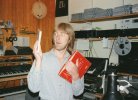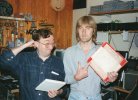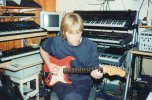The Archivist’s Tale… TWR talks to Anthony Phillips’ s archivist, Jon Dann about the trials and tribulations of bringing the back catalogue back to life.
TWR: First of all, Jon, how did you first become involved with Ant?
JD: I first met Ant in November 1991 when I was one of the winners of the “Ant Day” competition that year. Prior to that I had discovered Ant’s music in 1988 thanks to a local independent record shop which had nearly all of his vinyl albums as import titles in the “Genesis” section. In common with many fans, the first of Ant’s albums I bought was The Geese & The Ghost but as the imports were quite expensive, the second one I bought was the original vinyl release of Harvest Of The Heart.
If you had told me back then that one day I would not only meet Ant but end up working on the re-release of many of his albums I would not have believed you for a moment! (I know the feeling, Jon - AH) |
|
TWR: When did you become involved with documenting Ant’s archive?
JD: When I first met Ant I saw the shelves full of tapes in his studio and it got me wondering what material was on them and when they had been recorded. A couple of year later Ant mentioned that in his attic he had a tuck box (like a small wooden chest) which had some ld tapes in it that it might be interesting to have a look at one day. I remember that we eventually persuaded Ant to bring the box out of the loft one Sunday afternoon in 1995 and he started playing a few of the tapes, little knowing what exactly we would discover! (That story has already been told in the pages of TWR though, dear readers - AH).
TWR: What were the first recordings you examined?
JD: The first recordings I checked and then transferred to a digital format were some of those tapes that came to light in the summer of 1995 which had been stored for many years in a tuck box that Ant had in his attic. They had been recorded on machines in a format which Ant no longer had the means to replay properly so I offered to transfer the tapes so that he could hear them again. The recordings included a copy of some of the original 1970 demos he recorded just after leaving Genesis as well as the demos Ant recorded with Mike Rutherford in September 1969 on a borrowed tape recorder.
TWR: Apart from the well documented From Genesis To Revelation recording which was found in the summer of 1995, have you encountered any other material from Ant’s time with Genesis and if so, can you give us a few details on what these recordings are exactly and what condition they were in?
JD: The other Genesis recording that came to light at the same time as the From Genesis To Revelation tape was a copy of the very first demos recorded by Brian Roberts in April 1967. Tony Banks also has a copy of them and it was planned to include the instrumental version of Patricia from it on the Genesis Archive set but the sound quality was somewhat variable. Happily Ant’s copy of the tape was of better quality so ended up being used as the source for the track on the Genesis release. |
|
Several years later I was checking a tape and discovered that it included a short part (around two minutes) of a live performance of Stagnation. The exact date and location of the recording are unknown but Ant thinks it likely that it was recorded using the Beocord tape recorder that he and Peter Gabriel bought together almost as he was about to leave the group and there is a chance that it could be from Ant’s final gig with the group in July 1970 although this is not confirmed.
Both of these tapes were in good condition and didn’t require baking before being played.
TWR: Ant is luckier than most in having the bulk of his own master recordings at home. That said, have there been any notable omissions from that and what steps have been taken to retrieve them?
JD: Probably the most notable missing recording from Ant’s albums was the original 16 track master of the end of Collections and Sleepfall from The Geese & The Ghost. I knew that it had been recorded at Olympic Studios in November 1976 but couldn’t find a tape box with any corresponding details written on it. Then when we had the original 16 track masters for The Geese & The Ghost transferred to digital, we let the master tape which contained Which Way The Wind Blows and God If I Saw Her Now keep playing after the two songs. It had become one of the unwritten rules of transferring analogue masters to always check them right to the very end to make sure that there isn’t something else recorded on it not written on the tape box or track sheets. And this proved to be the case with this master, as after a pause, the previously missing recordings suddenly started playing. This discovery meant that we had the whole album in multi track form and in turn made the remixing of the album in 5.1 Surround Sound a possibility.
TWR: How much more material remains to be documented or is the archive now completely digitally archived?
JD: Based on material recorded on physical tapes across all formats ( as opposed to any material recorded purely as files) my estimate is that to date around 50% of Ant’s complete archive has been transferred to a digital format and the content has been documented. So there is still a long way to go until the whole archive has been digitised - and potentially a lot more material to discover.
TWR: Each album must have presented you with its own unique challenges, can you outline some of them? |
|
JD: The Geese & The Ghost, Wise After The Event, Sides and 1984 were all remixed in 5.1 Surround Sound for the Esoteric reissues. The challenge to each of these titles was to ensure that all audio material for each album was available together with as much contemporary documentation relating to the recordings as I could find so that Simon Heyworth and Andy Miles hopefully didn’t have to spend too which time figuring out where everything was. The Geese… in particular this required not only the copying of all the original track sheets and putting them in order but also documenting where the tracks that make up pieces like Wind Tales actually are.
Sides was an interesting project as the four tracks on the second side of the original album release (Sisters Of Remindum, Bleak House, Magdalen and Nightmare) had been initially recorded on 16 track and then had overdubs recorded on a separate 24 track master which was synchronised with the first tape for the mixing of the album. Both of the relevant tapes had to be baked, transferred and then the two recordings synchronised using the SMPTE time code on them. The big challenge for 1984 was putting the original track sheets into a form which would be of use to Simon and Andy. As the album was recorded in sections which were then edited together, the track sheets were complicated and were going to be very difficult to copy and keep in a coherent order. So I set to the task and wrote out the sheets for Part Two in particular again from scratch - I ended up with thirty four sheets to document FIFTEEN minutes of music!
Slow Dance was by far the most complicated and involved of all the reissues for a number of different reasons. The album was initially recorded on a single 16 track machine and the recording process was then expanded to make use of a second machine which ran in synchronisation with the first one. The challenge of getting the two masters for each side of the album precisely back in synchronisation and then transferring the audio to a digital format took the better part of nine hours.
The next part of the project was to transfer the original 2-track masters of the album - they contain the different sections of the album as individual pieces which were then digitally edited together at CBS Studios . When we began the transfer of these tapes we soon discovered that the original splicing that Ant had used to physically edit the tapes together at the time had deteriorated in the intervening years. This meant that the tape would often stick or catch on the edits requiring them in some cases, to be replayed several times until we could get a clean transfer of the relevant part where the tape didn’t stick. Some of the other edits fell apart when the tape was played and had to be repaired using new splicing tape. As a result, it took several hours to transfer the first master for the album. We then found that, despite having been baked, the second master for the album was still shedding oxide so it had to go back into the oven and be baked again so that it wouldn’t be damaged when it was played.
Simon Heyworth then had the unenviable task of not only creating the 5.1 Surround Sound mix of the album with Andy but also re-editing the sections of the original album back together again. There was a lot of work involved with this but the end result was well worth it as the sound quality of the album was significantly improved as a result of going back to the original masters.
TWR: Technology has changed enormously since Ant began his career. What challenges have those changes presented to you when trying to preserve this material?
JD: Accessing material were the original recording format is now obsolete remains the biggest challenge, as of course, it requires having fully working machines to replay the material so that it can be transferred to a digital format. In this respect, I am lucky to own several of the original tape machines in the same format thst Ant originally used such as the TEAC 4-track as well as the dbx noise reduction unit used on the recordings. The FX Copyroom also has all the original tape machines in the formats that would have been used in the studios when Wise After The Event and Sides were recorded so this has meant that it has been possible to transfer the master tapes for those albums. |
|
TWR: I am aware of some of the, shall we say, “spoof” tracks which Ant has recorded over the years. Have any others been found which are unlikely to see the light of day?
JD: Yes. (laughs).
TWR: Are there any recordings which you or Ant have not been able to find which you are still looking for?
JD: Yes, the original complete demo recordings from 1970 that Ant made just after leaving Genesis are a significant gap in the archive. Ant does have his notes from this time which gives most of the titles he recorded during those sessions and we also have the compilation tape of some the tracks which was rediscovered in 1995 from which the demos of God If I Saw Her Now and In Memoriam Ad were released on Archive Collection Volume One.
The one multi track master that is currently missing is the 16-track master for the music that was later released as the Scottish Suite on Back To The Pavilion.
Other missing recordings include the original demo of Take This Heart which had a group of friends including Phil Collins singing the hymn - we believe that the tape of it was sent to Charisma Records without being copied first. Another gap is the tape of ten demos recorded by Anon in April 1966 - which includes what Ant remembers as the superior version of Pennsylvania Flickhouse, a cover version of The Rolling Stones’ song Lady Jane and the original of the dong Patricia which eventually - with different lyrics - became In Hiding on From Genesis To Revelation.
TWR: What are the stages you go through from selecting a tape from the archive to finally having a digital copy of the material on it?
JD: The initial selection of a tape is usually based on the available information about the contents which accompany it - both in terms of what is written on the tape box and any track sheets that may be included inside the tape box. Sometimes Ant will also have some notes about the contents of particular tapes written in notebooks which can also give some clues as to what was recorded on it. The next step is to take the tape to the FX Copyroom in West London where it will be baked in a convection oven for several days so it can be played without the oxide shedding from the tape. Once baked, the tape is then transferred to a digital format and whilst this is done, I will always make notes of what is actually contained on the tape to see how accurate (or in some cases not!) the documentation for the tape actually is. From there it is a case of listening to the digital copy of the tape and identifying which recordings may be suitable for inclusion on a re-issue.
TWR: Digital technology is a superb tool but it can also reveal flaws in material such as this. How do you go about avoiding that or reducing it to a minimum?
JD: Digital editing and restoration software means that it is possible to address and repair technical issues that might otherwise prohibit the release of a track or to carefully edit some parts together to create a final complete track.
TWR: Of all the albums you have been involved with, which one(s) are you best pleased with and why? |
|
JD: It is difficult to single out just one album as there have been a number of discoveries I have made of previously unreleased material that have now seem the light of day as extra tracks, which I think are on a par with pieces on the original albums. The discovery of the full versions with real drums like Alex and Finale from the Invisible Men sessions were one highlight. The acoustic guitar pieces such as Skylarks Over The Water and The Riddle Of The Sands on Private Parts & Extra Pieces II were another. I was also very pleased to find the tracks that were included on Private Parts & Extra Pieces III.
TWR: Apart from Tarka (which is mentioned in Ant’s interview elsewhere) What remains from the back catalogue that is likely to be re-issued at some point?
JD: The remaining titles from Ant’s back catalogue which are due for re-issue are the four Missing Links albums (Finger Painting, The Sky Road, Time & Tide and Pathways & Promenades), Living Room Concert, Radio Clyde. Sail The World, Ahead Of The Field and the two volumes of Archive Collection.
TWR: Is there a prospect, after all this research, of a further Archive Collection at some point? Should we get ready to reconvene the Listening Panel…?
JD: There is indeed a prospect of a further Archive Collection - if the Listening Panel can face it!
I shall get my coat! My thanks to Jon for taking the time to provide such a fascinating insight into how these projects are put together.




